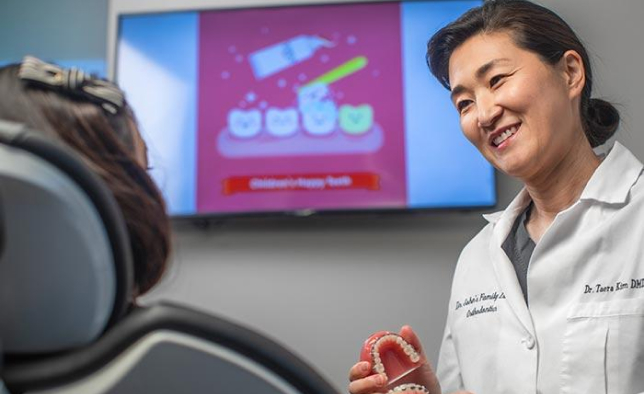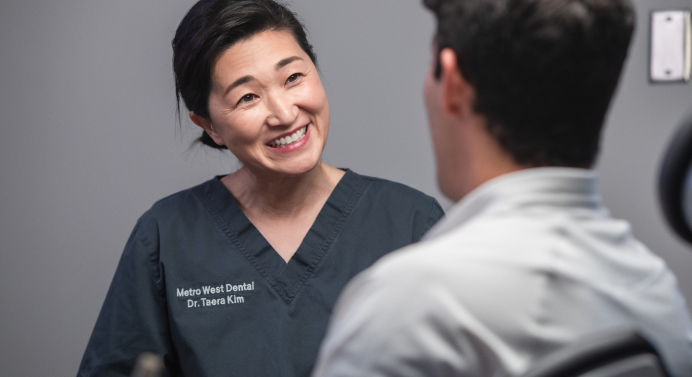The key to orthodontic tooth movement is applying continuous light pressure to teeth. This pressure is then applied to the bone, causing it to remodel and allowing the teeth to move.
Traditional brackets or invisalign are methods to apply this pressure to the bone.

Children/ Adolescent
Early orthodontics is a crucial aspect of dental health, focusing on the unique opportunities that the growth potential of children offers for correcting dental irregularities. Unlike adult orthodontics, where the jaw and facial bones have typically stopped growing, the dynamic growth phase in children allows for more than just alignment of the teeth; it can also influence the development of the jaw and facial structure in a positive way. First orthodontic consultations usually occur when upper central teeth are fully erupted, typically around 6-7 years of age. Early intervention is strategic because it allows our orthodontist to evaluate the dental and facial development of the child and plan for any necessary interventions that can guide their growth potential. Research suggests that early intervention, particularly when some baby teeth are still present, can address moderate crowding issues without the need for tooth extractions. Techniques like maxillary expansion can correct skeletal underbites, overbites, and crossbites with minimal force and promote normal behaviors such as nasal breathing, proper tongue resting position, and good sleep habits by optimizing oral space to enhance the airway is crucial at this growth stage. This proactive approach can lead to better outcomes and less invasive treatments compared to starting orthodontics in adulthood.
Early orthodontics is a crucial aspect of dental health, focusing on the unique opportunities that the growth potential of children offers for correcting dental irregularities. Unlike adult orthodontics, where the jaw and facial bones have typically stopped growing, the dynamic growth phase in children allows for more than just alignment of the teeth; it can also influence the development of the jaw and facial structure in a positive way. First orthodontic consultations usually occur when upper central teeth are fully erupted, typically around 6-7 years of age. Early intervention is strategic because it allows our orthodontist to evaluate the dental and facial development of the child and plan for any necessary interventions that can guide their growth potential. Research suggests that early intervention, particularly when some baby teeth are still present, can address moderate crowding issues without the need for tooth extractions. Techniques like maxillary expansion can correct skeletal underbites, overbites, and crossbites with minimal force and promote normal behaviors such as nasal breathing, proper tongue resting position, and good sleep habits by optimizing oral space to enhance the airway is crucial at this growth stage. This proactive approach can lead to better outcomes and less invasive treatments compared to starting orthodontics in adulthood.

Adults
Adults seek orthodontic care for various reasons, often including worn teeth, missing teeth, bone loss, TMJ pain, and gingival recession. Due to the complex nature of their oral conditions, treating each patient in private rooms with personalized care is recommended. The goal for adult patients is to achieve ideal function, characterized by a stable condylar position with adequate anterior and canin guidance and even pressure during closure. Establishing a clear goal and final vision – referred to as creating a blueprint – is essential for effective communication between the patient and the entire oral care team, which may include restorative dentists, dental specialists, oral surgeouns, and physical therapists.
Adults seek orthodontic care for various reasons, often including worn teeth, missing teeth, bone loss, TMJ pain, and gingival recession. Due to the complex nature of their oral conditions, treating each patient in private rooms with personalized care is recommended. The goal for adult patients is to achieve ideal function, characterized by a stable condylar position with adequate anterior and canin guidance and even pressure during closure. Establishing a clear goal and final vision – referred to as creating a blueprint – is essential for effective communication between the patient and the entire oral care team, which may include restorative dentists, dental specialists, oral surgeouns, and physical therapists.
Contact us today at 402-614-7022 to learn more about traditional braces therapy in La Vista, Nebraska, and the surrounding areas of Elkhorn, Omaha and Papillion, Nebraska. Schedule your appointment with Dr. Kim!


 402-614-7022
402-614-7022